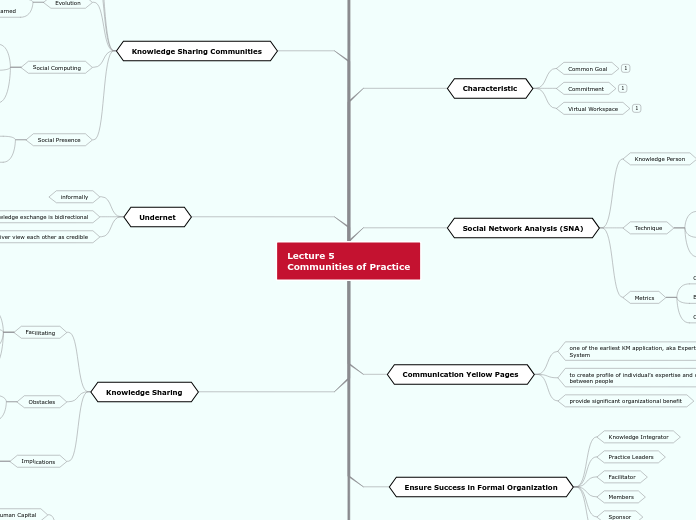Lecture 5
Communities of Practice
Forms of Joint Work in Organizations

Characteristic
Common Goal
Commitment
Virtual Workspace
Social Network Analysis (SNA)
Knowledge Person
Knowledge Hoarder
Knowledge Sharer
Knowledge Broker
Technique
visualization tools that can be used together with surveys
Cluster Analysis - process of identifying highly integrated subgroups
can be automated (e.g. email mapping)
Metrics
Centrality
Betweenness
Closeness
Communication Yellow Pages
one of the earliest KM application, aka Expertise Location System
to create profile of individual’s expertise and connections between people
provide significant organizational benefit
Ensure Success in Formal Organization
Knowledge Integrator
Practice Leaders
Facilitator
Members
Sponsor
Champion
Roles and Responsiblities
Visitors
Novices
Regulars
Leaders
Elders
Knowledge Sharing Communities
Provide access to data and documents
Interconnecting the social networks of people who produced the knowledge
Evolution
Best Practice
Lessons Learned
Social Computing
Digital systems that draw upon social information and context
to enhance the activity and performance of people, organizations and systems.
Example
- recommender systems such as those the advise you on which books you would enjoy
Social Presence
How much of a sense members have that other people are present
Example
- Facebook news feed on recent posts on friend's walls
Undernet
informally
Knowledge exchange is bidirectional
Sender and receiver view each other as credible
Knowledge Sharing
Facilitating
knowledge is power
knowledge is property
organizational culture and climate
credibility of content and the source
Obstacles
rewarded for what they know
disincentive to share
lack of trust between provider of knowledge and receiver of knowledge
Implications
Connecting professionals across platforms, across distances.
Standardizing professional practices.
Avoiding mistakes
Organizational Learning & Social Capital
Human Capital
education, skills and background necessary to be productive in an organization or profession
Social Capital
institutions, relationships and norms that shape the quality and quantity of an organization's social interactions
Values
different than other types of capital
maintenance of positive relations between different subgroups
need strong relationships within groups as well as "bridging" ties between groups
Hard to quantify value
